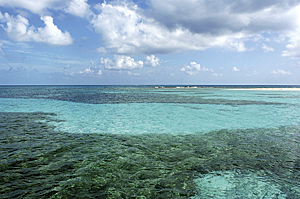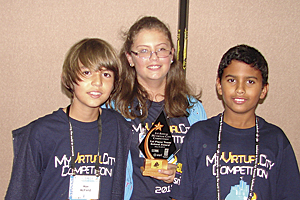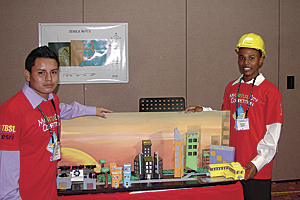ArcUser
Fall 2012 Edition
Designing a Better Future for Belize
By Monica Pratt, ArcUser Editor
This article as a PDF.

Although you can't go there now, you might want to visit Terra Nova or Nebulous in 2027.
These two cities were winning entries in a contest to design sustainable cities in the Central American country of Belize. The My Virtual City Competition, sponsored by Total Business Solutions Limited (TBSL), Esri's local distributor in Belize, and the United Nations Development Programme (UNDP) Belize, challenged students in primary and secondary schools to envision a city for 50,000 residents set 15 years in the future. The contest theme was Designing Our Future, Mobilizing People for Change!
"This competition is about more than just kids experiencing GIS; it's about working together to sustain our world. We have an opportunity here to create a more spatially literate and socially developed society," said Regina Campbell, marketing and business development manager at TBSL and the coordinator of the contest.
More Than Just a Contest
With almost half of the world's population of seven billion people currently living in cities and that figure expected to rise to 60 percent by 2030, the need for innovative approaches to sustainable city design has never been greater. The Rio+20 United Nations Conference on Sustainable Development in June 2012 highlighted some of the problems associated with this trend. Although they occupy just 2 percent of the earth's surface, cities account for between 60 and 80 percent of energy consumption, produce 75 percent of carbon emissions, and increasingly exert pressure on freshwater supplies.
The TED committee recognized the pivotal role of city design by awarding the 2012 TED Prize to an idea, City 2.0, "the city that works," rather than an individual. "This idea is capable of inspiring millions of people around the world to contribute to one of the biggest challenges and opportunities humanity faces," the committee stated when making the award. "The City 2.0 is not a sterile utopian dream, but a real-world upgrade tapping into humanity's collective wisdom."
From SimCity to Farmville, games that let players escape from the real world by creating landscapes that satisfy individual desires have become tremendously popular. Now, the technology that creates these refuges from reality is poised to take on a more serious role. Esri has combined virtual reality technology with the spatial analysis tools of traditional GIS, resulting in powerful collaborative tools for designing cities.
These tools engage and inform more than just policy makers. In the words of Esri president Jack Dangermond, "Smart cities of the future will be those where the citizenry is engaged in their design and evolution, where we fully leverage the collective intelligence of the masses and allow everyone to actively participate in shaping our communities." Esri supported the young citizens of Belize who are tackling some of the world's most serious challenges by donating ArcGIS for Desktop Basic for Home Use licenses to carry out the projects and as prizes for the contest.
Tackling Serious Problems
The first My Virtual City Competition was announced November 16, 2011, during the World GIS EXPO held at the Best Western Belize Biltmore in Belize City. Students would use GIS to research and design sustainable cities. Their designs would be summarized in a brief narrative listing their city's key attributes and special features, reproduced as a physical model built to scale using recycled materials, described in detail in a 1,000- to 2,000-word essay, and explained in a 10-minute presentation to be given at the contest exhibition on May 23, 2012, at the Princess Hotel in Belize City.
As they developed city designs, students learned how GIS can be used for planning and problem solving. Over the course of five training sessions with TBSL, as well as additional one-on-one coaching, they also learned how to use Esri software. Beyond technical training, the contest enhanced students' leadership skills and teamwork and made them more aware of human rights and national and international development standards.
Winning Designs
Teams competed in two categories: primary school and secondary school. Students' entries demonstrated innovative approaches to city planning that addressed environmental, societal, and economic concerns. First prize winners received laptops and ArcGIS for Desktop Basic Home Use licenses. Second prize winners received smartphones and ArcGIS for Desktop Basic Home Use licenses. Third prize winners received Apple iPods and ArcGIS for Desktop Basic home user licenses. Winning teams' schools also received a $500 honorarium and a plaque.

In the primary school category, Max McField, Chloe Kelly, and Ethan Singh from Belize Elementary School took first place for their city called Nebulous.
Max McField, Chloe Kelly, and Ethan Singh from Belize Elementary School took first place in the primary school category for their city called Nebulous. Kelly described the city as eco-friendly with many job opportunities and sustainable energy supplied by solar and wind power. Brandon Bennett and O'Sean Hyde of Horizon Academy took second place in this category with their city Arcadia. The pair have high hopes for their city. "Arcadia is an eco-friendly, technology-based city that provides safety first and great entertainment. The city hopes to improve Belize and find its way onto the map as the best little city in the world." Bennett and Hyde also won prizes for Best Use of Millennium Development Goals and Best City Layout. Jordan Campbell and Zazie McKenzie of Belize Elementary School received third place for the design of their city, Healthmore.

In the secondary school category, Corozal Community College students Philip Gongora and William Mahler won for their design of Terra Nova.
In the secondary school category, Corozal Community College students Philip Gongora and William Mahler won for their design of Terra Nova, "the city of opportunity." In addition to capturing the overall prize, the pair also won prizes for Best City Layout, Best Use of GIS, and Best Use of Millennium Development Goals. Samantha Chan, Armando Perez, and Asher Canto from Edward P. York High School took second place overall with the City of Jex design. They also won the award for Best Team Work. Jovan Gongora, Trei Solis, and Lance Howard of Belize High School, who designed the city of Je La Tron, comprised the third place team.
In the course of completing their My Virtual City entries, all students were required to comprehensively address the needs of their cities from basic services, such as sanitation, water, and power, to employment opportunities to recreation and education facilities. This contest, in the words of contest sponsors TBSL and UNDP, can help "the younger generation to become strategic decision makers who understand how planning and decisions impact our lifestyle, community, nation, and world."
For more information, contact TSBL at info@tbsl.bz.